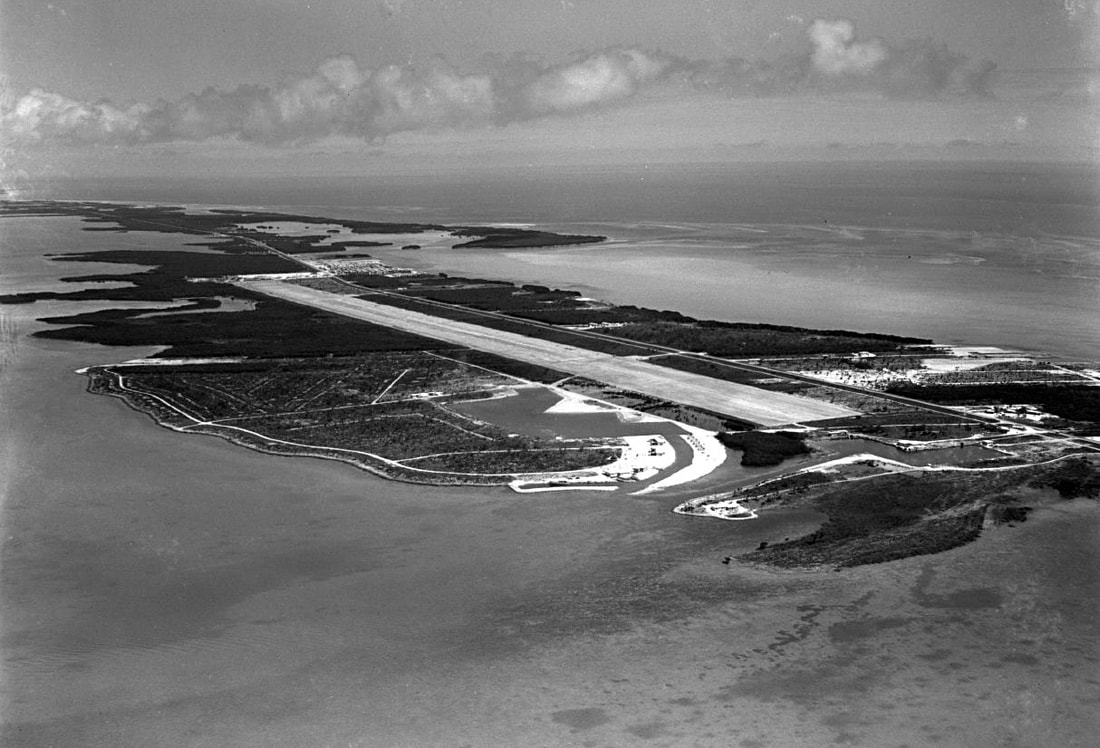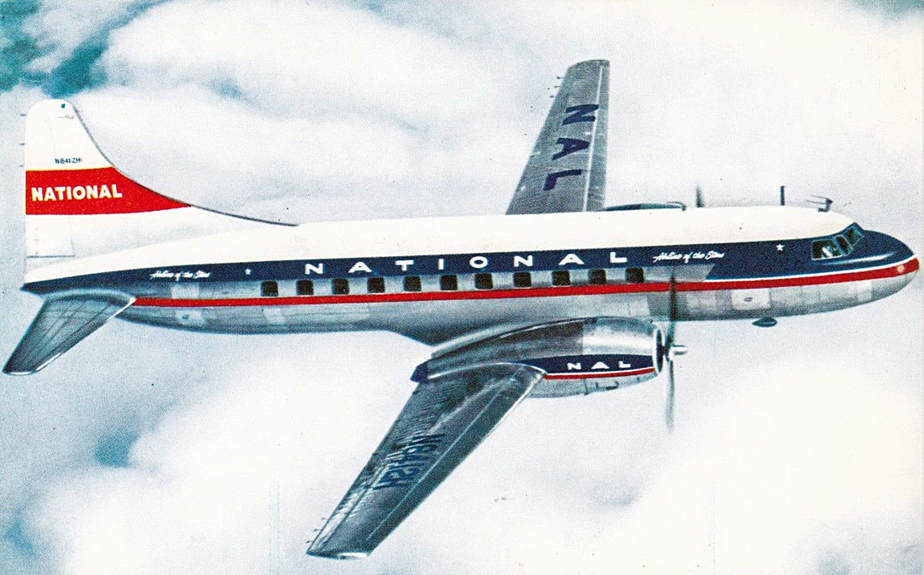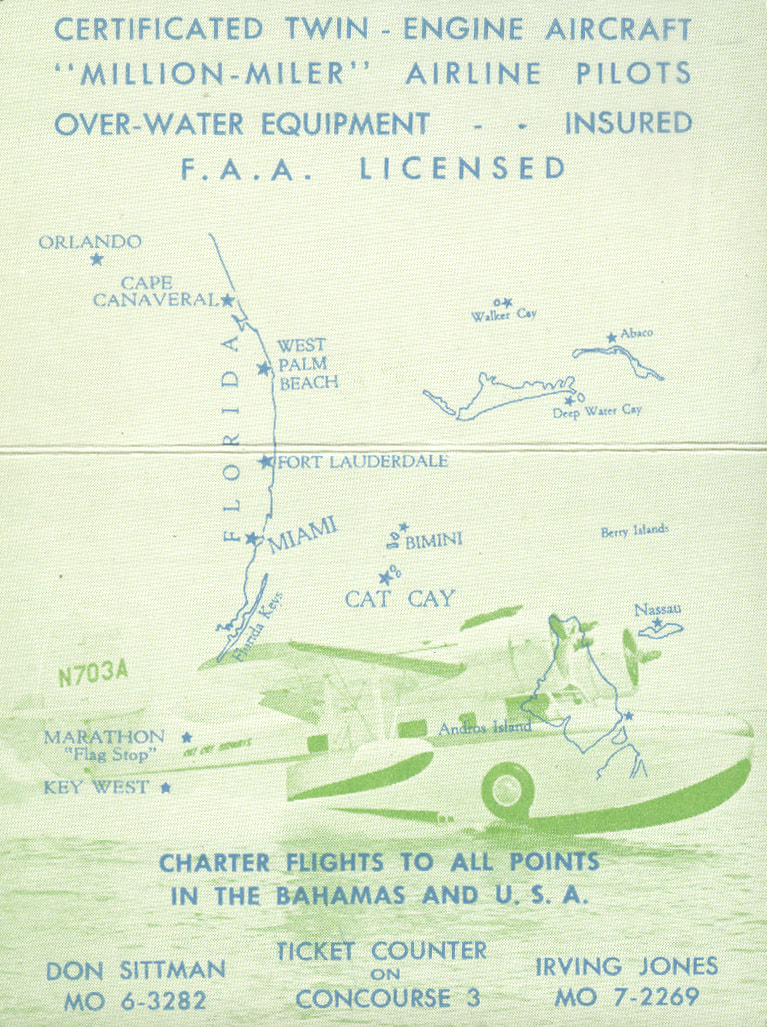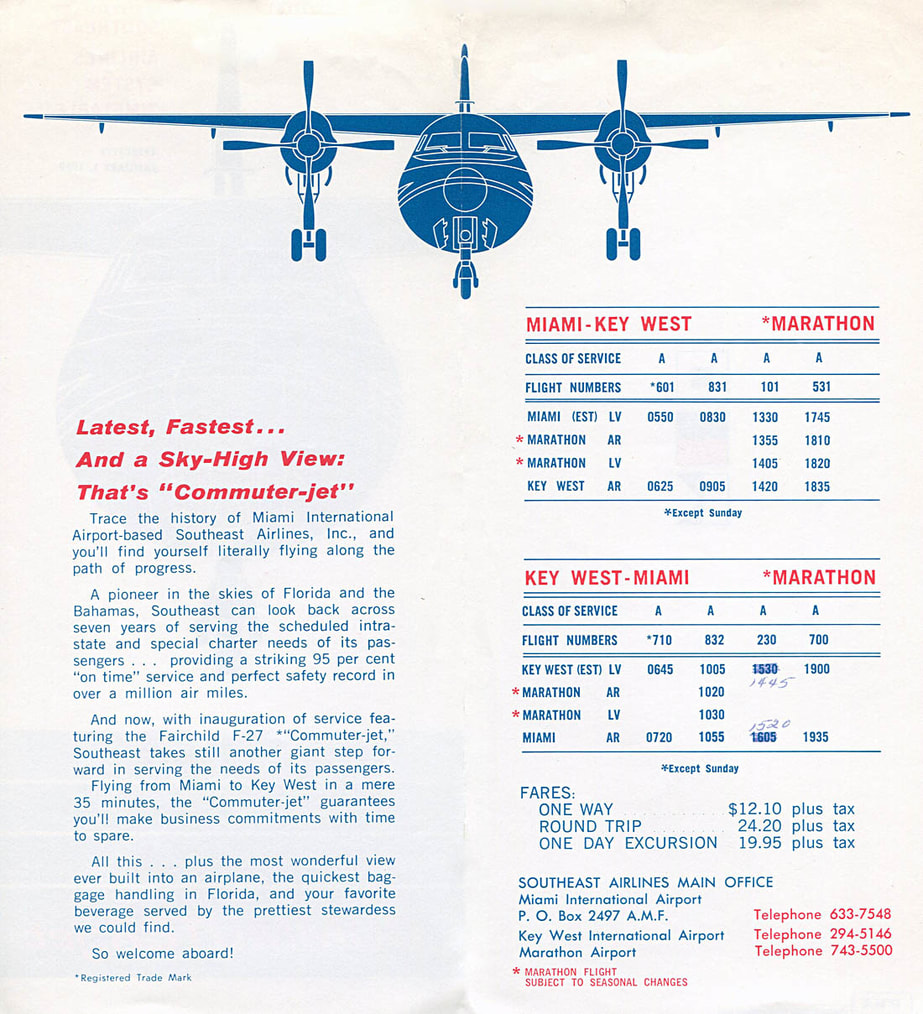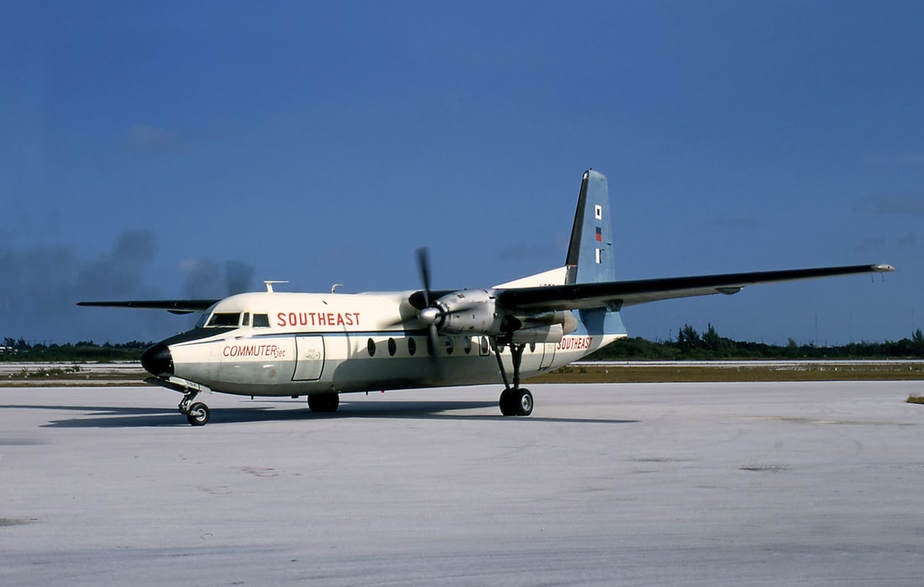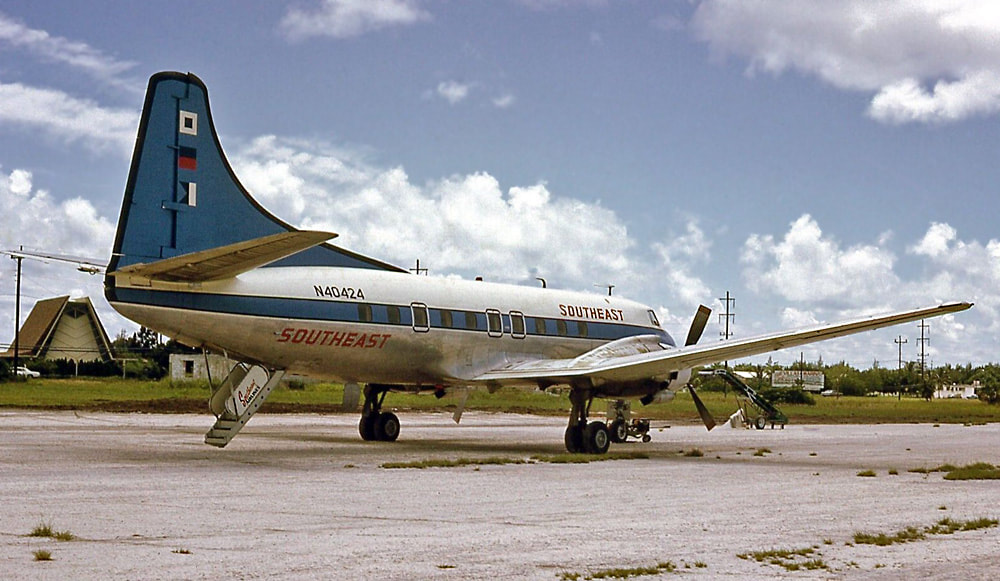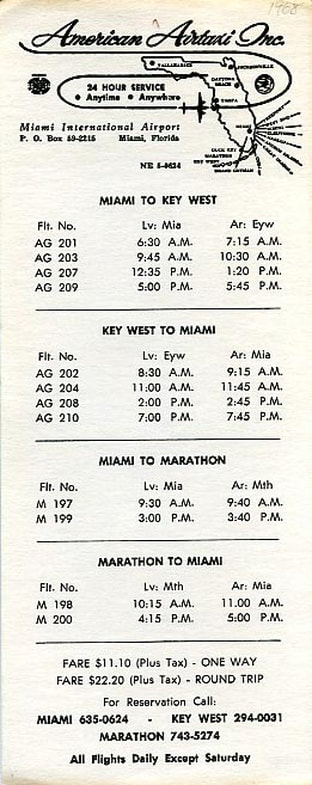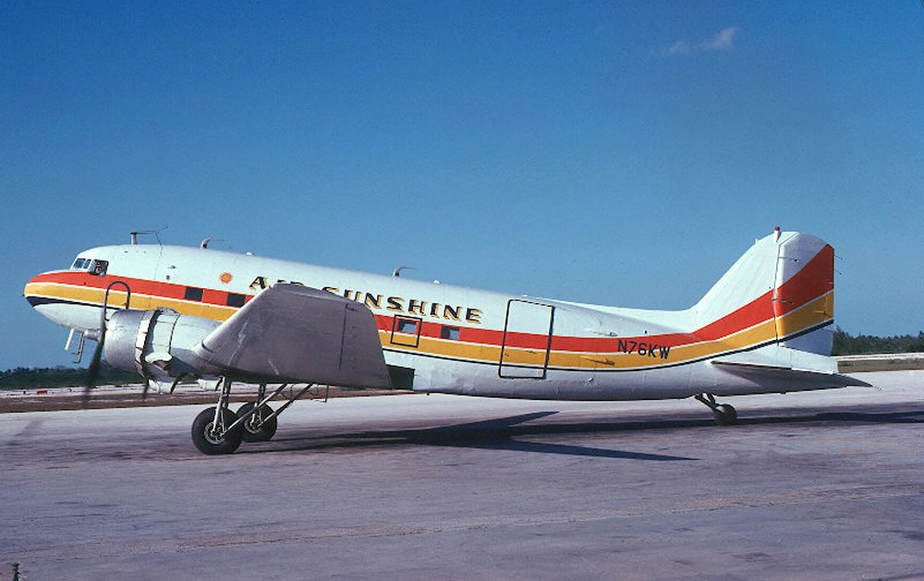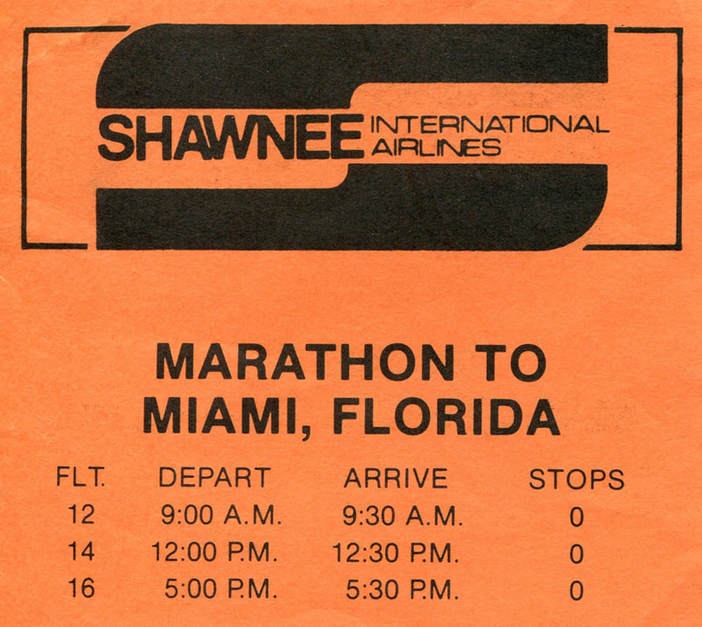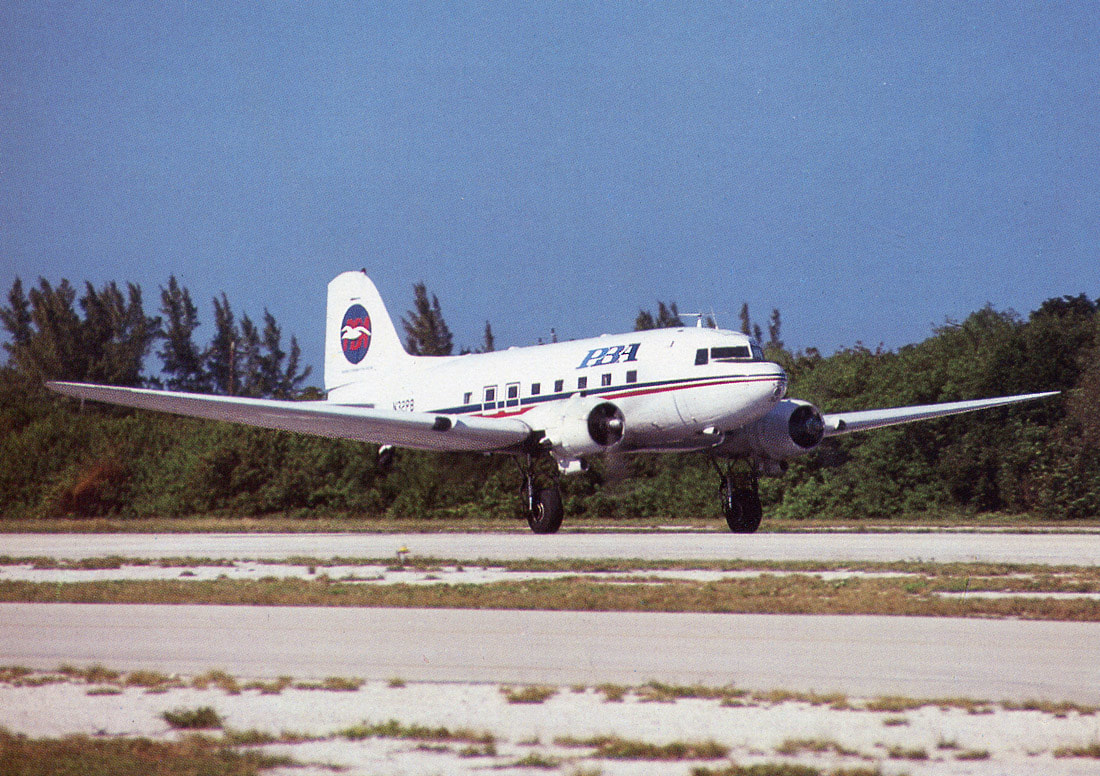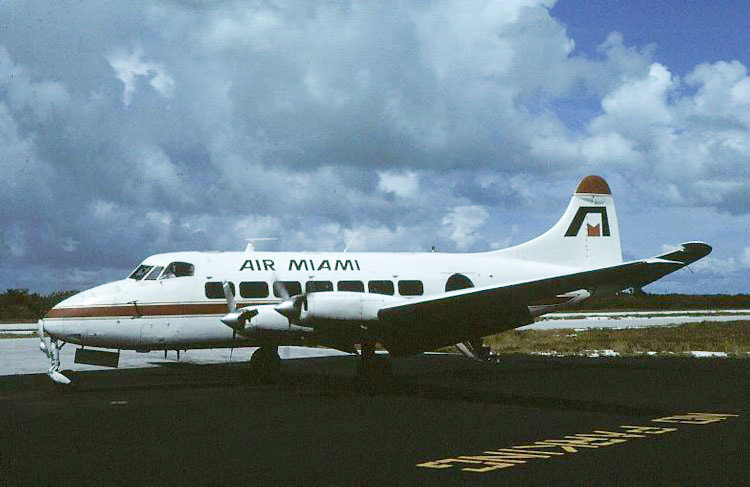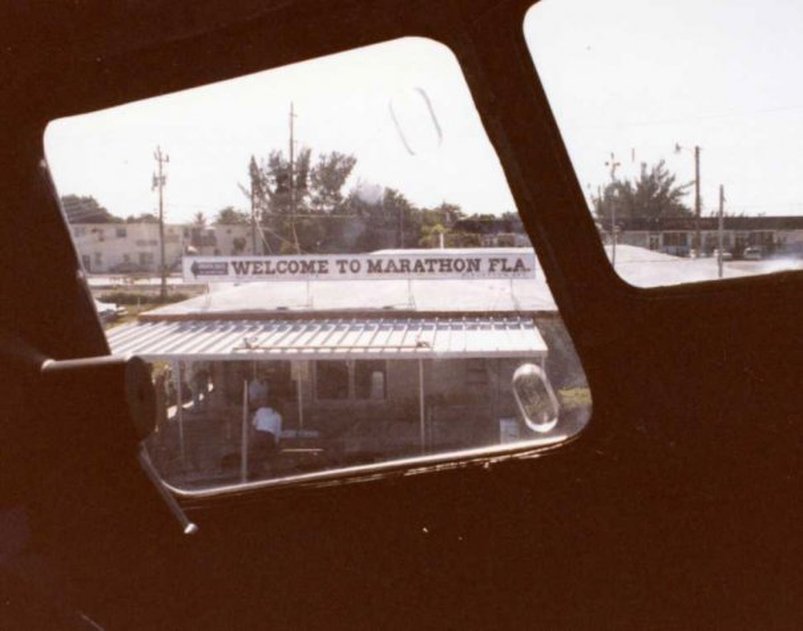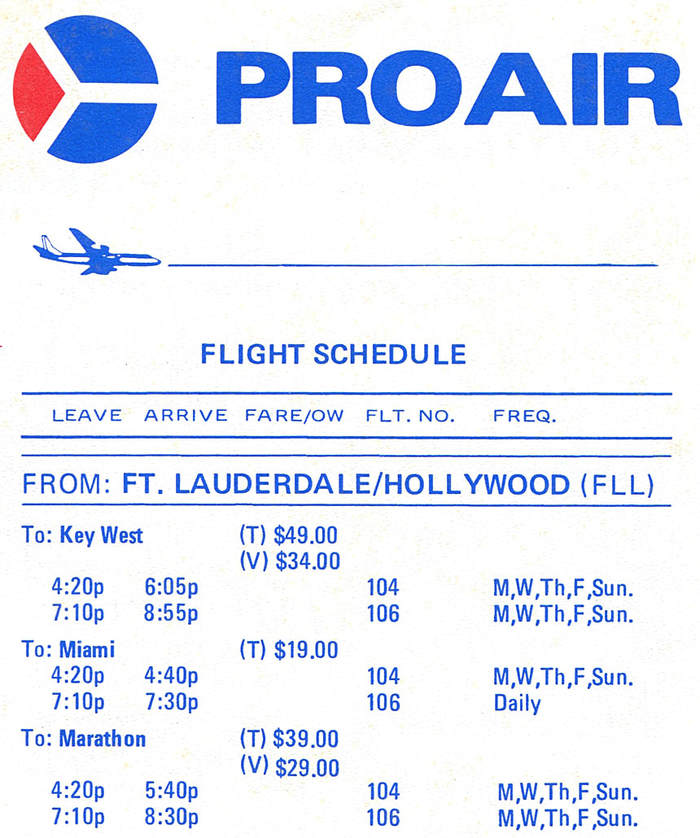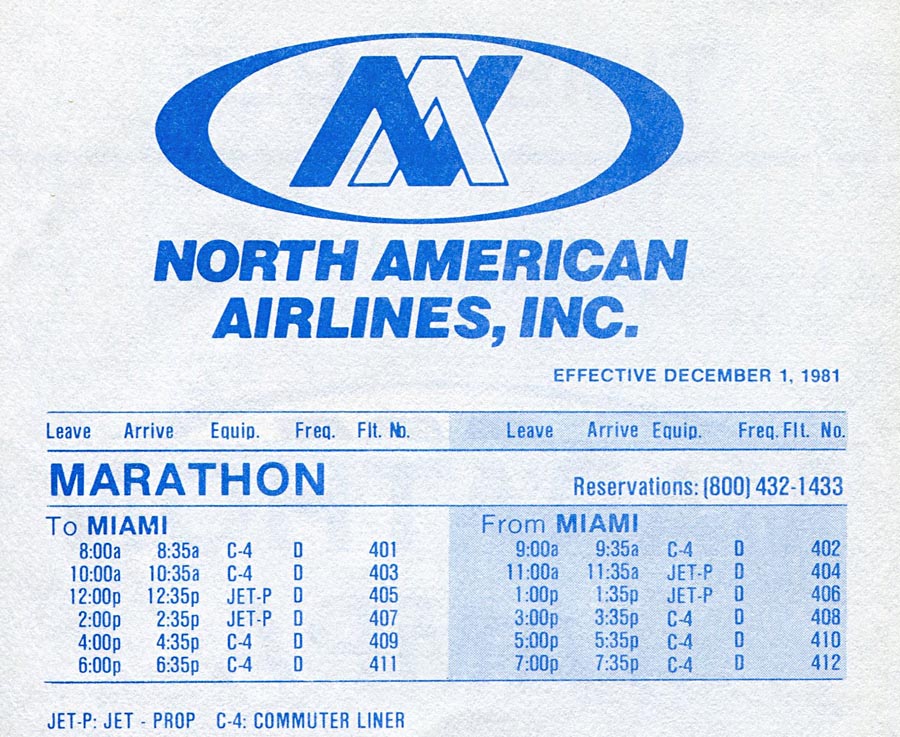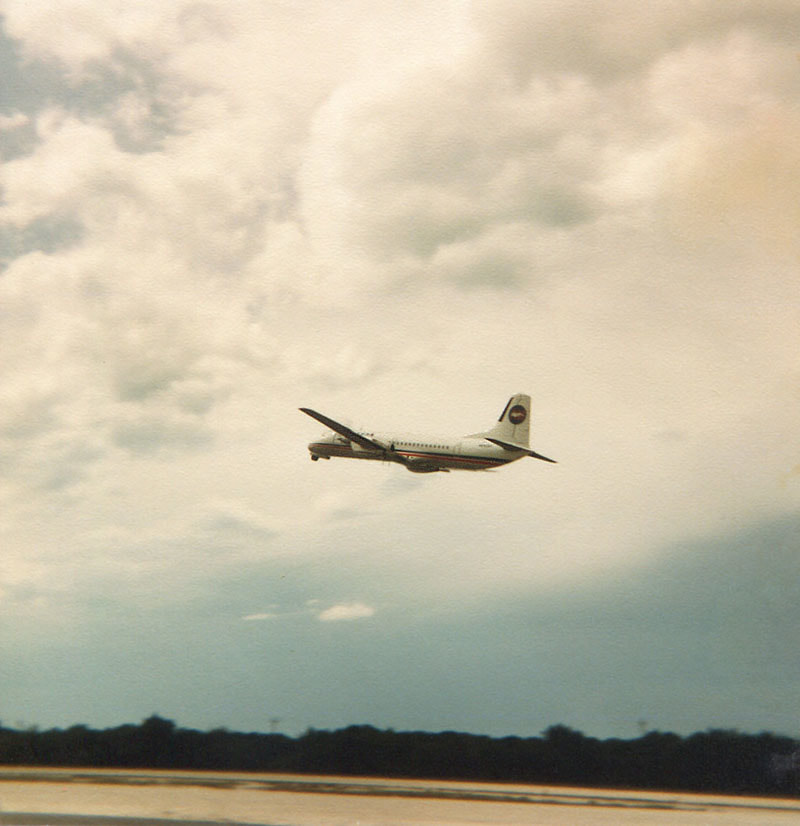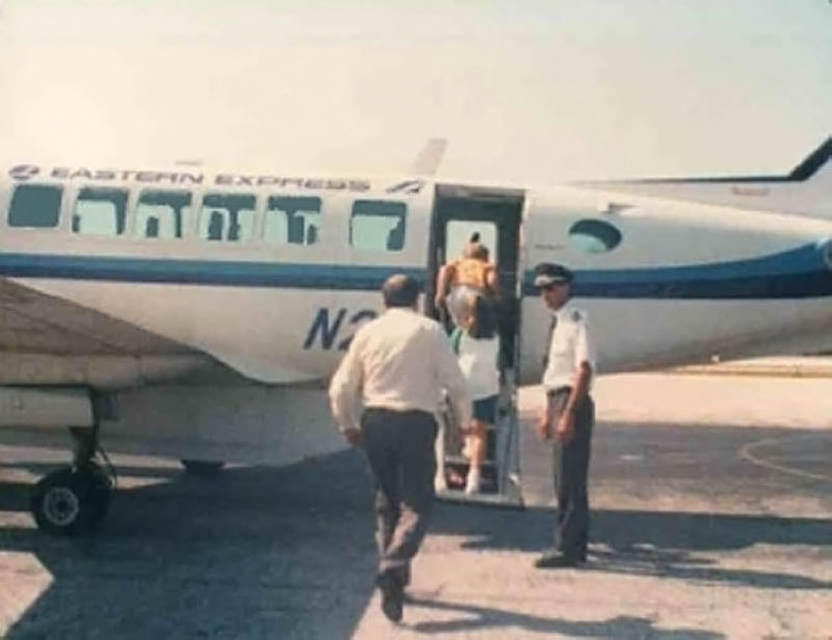HISTORY OF AIRLINE SERVICE AT MARATHON, FL
Part one: 1942 - 1989
Marathon Airport was built during World War II for the military as an outlying emergency airfield and a practice strip for pilot training. Edward Belcher, owner of the Belcher Oil Company in Miami, was the primary contractor and transformed the 280 acre parcel of mangroves and scrub into an airfield in about six months. Construction, which mostly involved dredging and moving fill dirt, began in the fall of 1942 and was completed in spring 1943.
An aerial view from March 18, 1943 shows the basic airport near completion. Photo from the National Archives via Tony Daiuto.
An aerial view from March 18, 1943 shows the basic airport near completion. Photo from the National Archives via Tony Daiuto.
This aerial view of Marathon in 1955, facing east, shows the airport as a simple gravel airstrip with no buildings or facilities. The borrow pond used for fill is now Dodge Lake. Photo courtesy of the Florida Keys Public Libraries. Copyright Edwin O. Swift Jr. from the archives of Edwin O. Swift III.
Following the war, Monroe County was granted title to the property and began operating it as a public airport in 1958. National Airlines began service to Marathon on a flag-stop basis on runs between Miami and Key West on November 10, 1959. Civil Aeronautics Board statistics show that National carried 174 passengers on 75 departing flights from Marathon through the end of the year. 44-passenger Convair 340s were used on all flights. 682 passengers were carried aboard 480 departures in 1960, National's only full year of service at Marathon.
This is a photo from National's opening day at Marathon. Courtesy of EAA Chapter 1241 from the Nancy Agnew collection via Tony Daiuto.
This is a photo from National's opening day at Marathon. Courtesy of EAA Chapter 1241 from the Nancy Agnew collection via Tony Daiuto.
A color postcard view of a National Airlines Convair 340.
Postcard view of Marathon Airport facing east circa 1960.
Service to Marathon was discontinued in mid-1961 as National Airlines transitioned to turboprop and pure jet aircraft that were too large for the relatively short runway and light passenger demand in the middle keys.
In response to National's service cuts, Southeast Airlines was formed to fill the gap. The carrier was certified on September 25, 1962 and service to the Keys commenced on November 1st. Two daily round trips were flown between Miami and Key West with Marathon once again served as a flag-stop.
In response to National's service cuts, Southeast Airlines was formed to fill the gap. The carrier was certified on September 25, 1962 and service to the Keys commenced on November 1st. Two daily round trips were flown between Miami and Key West with Marathon once again served as a flag-stop.
This Southeast Airlines timetable effective January 1, 1969 shows 3 daily stops at Marathon along the Miami - Key West route: 2 southbound and 1 northbound. All flights were operated with modern 44-passenger Fokker F-27 turboprops.
Southeast Airlines F-27 "Commuter-jet" pictured at Marathon in April 1972. Photo courtesy of Bob Garrard.
Southeast began flying 1950s-vintage Martin 404s to the Keys in late 1971. The step back from modern turboprops to older piston-engine airliners earned Southeast quite a bit of bad publicity in the Keys at the time. In June 1973, the Monroe County Commission publicly criticized Southeast for poor service, not upgrading their aircraft and flying planes that one official described as "95-cylinder rattley-bangs".
N40424 is seen on the ramp at Marathon in 1972. This particular aircraft would later fly with PBA.
N40424 is seen on the ramp at Marathon in 1972. This particular aircraft would later fly with PBA.
American Air Taxi, or AAT, flew to Marathon intermittently during the late 1960s and early 1970s. This timetable from 1968 shows two flights a day between Miami and Marathon. The October 1, 1971 Official Airline Guide also shows two flights a day using twin Cessna equipment while the airline's timetable effective February 1, 1972 shows no service to Marathon. Timetable from the Craig Morris collection via timetableimages.com.
American Air Taxi became Air Sunshine in 1974 and returned to Marathon late in the year flying DC-3s on the Miami - Marathon - Key West route. The airline also offered Marathon to Tampa service via Key West.
In 1975, Southeast and Air Sunshine signed a "covenant not to compete" agreement in which Air Sunshine paid $500,000 to persuade Southeast to drop all service to the Florida Keys. Southeast departed Marathon and Key West in November 1975, leaving Air Sunshine as "The Florida Keys Own Airline".
In 1975, Southeast and Air Sunshine signed a "covenant not to compete" agreement in which Air Sunshine paid $500,000 to persuade Southeast to drop all service to the Florida Keys. Southeast departed Marathon and Key West in November 1975, leaving Air Sunshine as "The Florida Keys Own Airline".
A familiar sight repeated many times a day in the mid and late 1970s: an Air Sunshine DC-3 departing Marathon for a short hop across Florida Bay to Miami or Key West.
Air Sunshine's business was booming in the mid 70s and two 44-passenger Convair 440s were purchased in 1977 to handle the increasing passenger loads.
This detail from the February 1, 1978 timetable shows 8 daily departures from Marathon with an even mix of DC-3s and Convairs.
Air Florida took over Air Sunshine on December 1, 1978. For the next few months, very little changed in the day to day operations at Marathon. The flights were billed as Air Florida Sunshine, but the DC-3s and Convairs continued to fly in Air Sunshine colors.
Shawnee International Airlines made a brief and unsuccessful attempt to crack the Marathon market in spring 1979 with 3 daily round-trips to Miami. DOT records show that Shawnee boarded a total of 62 passengers at MTH before calling it quits.
On September 6, 1979 Air Florida retired the Air Sunshine DC-3s and Convairs that had become nearly legendary in the Florida Keys. For those in Key West, this meant an upgrade to pure jet Boeing 737 service. Unfortunately for those in Marathon, this meant a downgrade to 2 flights a day flown with an 18-seat Twin Otter wet-leased from Ocean Reef Airways along with a substantial fare increase. It was a move that infuriated travelers, residents and city officials who almost immediately began a movement to improve air service to Marathon and find an airline that could live up to the needs and expectations of the island city.
George Simone, a Marathon travel agent and past Chairman of the Transportation Committee of the Marathon Chamber of Commerce, spearheaded an effort to bring competitive service to Marathon. He contacted management at Provincetown - Boston Airline, a well established commuter airline in southwest Florida, and convinced them to enter the Marathon market. PBA had an excellent track record of customer service and a proven ability to build markets where other airlines had failed. They also had an existing interline agreement with Eastern Air Lines that allowed seamless connections in Miami. It was a perfect match.
PBA hosted an inaugural party for city officials and business leaders on nearby Duck Key on February 29, 1980. Service between Marathon and Miami began the next morning.
PBA hosted an inaugural party for city officials and business leaders on nearby Duck Key on February 29, 1980. Service between Marathon and Miami began the next morning.
This comparison shows the dramatic increase in flights at Marathon between 1979 and 1980. In the 1979 example, Air Florida (QH) offered only 2 flights a day using de Havilland Twin Otters (DHT) with a $33 one way fare. A year later, Air Florida was operating 4 flights using a mix of de Havilland Herons (DHH) and CASA 212s (CS2) at $26 one-way and PBA (PT) offered 6 daily flights, primarily with 30-seat DC-3s, with a one-way fare of $27. Traffic more than doubled in this period. This comparison comes from the Winter 1981 issue of the PBA Flyer newsletter.
A terrific postcard view of PBA DC-3 N32PB at Marathon on December 4, 1981.
In July 1980, Air Florida contracted Air Miami to operate the Miami - Marathon route. This de Havilland DH.114 Heron, N121G, flew the same route with Shawnee International Airlines a year earlier.
The contract arrangement with Air Florida was so successful that Air Miami became the first Air Florida Commuter carrier on October 26, 1980. Spanish-built CASA C-212 Aviocar N450AM is seen here in full Air Florida Commuter colors. The boxy fuselage gave the 26-passenger cabin a spacious "wide-body" look.
This view of the Marathon Airport terminal in 1980 shows recently added PBA signage. The sign at left reads "Fly PBA to Miami." You can see the nose of an Air Miami DH.114 Heron reflected in the window to the left of the pay phone. After PBA began flying into Marathon, Air Florida installed a trailer on the opposite side of the parking lot (it would have been directly to the right of the photographer in this view) and used that as the terminal for their commuter flights. Photo courtesy of the Florida Keys Public Libraries.
Here's the airside view of the terminal as seen from the cockpit of a PBA DC-3. Great shot! Photo credit: Dennis Sutton.
Pro Air was another airline that flew DC-3s to and from Marathon. In 1981 they briefly operated two Ft. Lauderdale - Miami - Marathon - Key West round-trips 5 days a week.
Air Miami ended its affiliation with Air Florida and became North American Airlines on December 1, 1981. On that date, they began hourly "Sun Shuttle" flights between Marathon and Miami using CASA-212s (shown here as JET-P) and Cessna 402s (shown as C-4). North American shut down a year later on December 9, 1982.
North American's CASA 212 N451AM on the ramp at Marathon in 1982.
PBA DC-3 N137PB at Marathon on December 29, 1982. I flew a Miami - Marathon round-trip that day just for the fun of flying a DC-3 over the Everglades and Florida Bay. $64 round-trip! I couldn't get a picture of the plane in a single shot so this is a combination of two separate photos.
Another view of DC-3 N137PB at Marathon on December 29, 1982.
Southern Express offered flights between Marathon and Miami from late 1984 through summer 1985.
This detail from the Southern Express timetable effective March 4, 1985 shows 4 flights to Miami on most days.
Provincetown - Boston Airline was somewhat unique in that they scheduled aircraft based on how many passengers were booked on a particular flight. Most flights to Marathon were flown with DC-3s but this 58-passenger YS-11 turboprop appeared during my visit to the airport in December 1985. The arriving flight was nearly full but only about a half-dozen passengers boarded the flight back to Miami. To my knowledge, this was the largest aircraft type ever flown in passenger service to Marathon.
A familiar scene at the old Marathon terminal, passengers posing in front of a waiting DC-3. N32PB was one was of PBA's youngest DC-3s and left the factory on October 23, 1941. Photo credit: Brett Stone, 1987.
Air South flew their Britten Norman Tri-Islanders between Marathon and Miami during 1986 and 1987.
Provincetown - Boston Airline became part of the Texas Air Corporation empire on February 1, 1987 and was merged into Bar Harbor Airlines on September 6, 1988. Flights continued as usual at Marathon, although Bar Harbor retired PBA's beloved DC-3s.
A Bar Harbor Beechcraft B-99 in Eastern Express colors is pictured at Marathon in 1988. Photo credit: Brett Stone.
The mid to late 1980s saw the proliferation of code-sharing in which commuter airlines would operate flights on behalf of an affiliated major airline, feeding traffic into their hubs and often painting their aircraft in the larger airline's colors. These flights would appear in reservations systems under the major carrier's two letter airline-code as if they were flown by the same airline, hence the term code-sharing.
The practice of code-sharing brought a huge increase in the number of flights to Marathon as major airlines tried to funnel passengers into their own respective hubs. As the 1980s came to an end, three airlines had code-share service at Marathon. Comair operated as a Delta Connection carrier to feed traffic into Delta's Orlando and Ft. Lauderdale hubs. Bar Harbor flew as Eastern Express with flights into Eastern's Miami hub and American Eagle also fed traffic into American Airlines' Miami hub. In addition, two independent commuter airlines, Airways International and a new Air Sunshine (unrelated to the 1970s company of the same name) were flying into the middle Keys. The result was an unprecedented level of service: 27 flights a day! 16 to Miami, 9 to Ft. Lauderdale, 1 to Orlando and 1 to Key West.
The practice of code-sharing brought a huge increase in the number of flights to Marathon as major airlines tried to funnel passengers into their own respective hubs. As the 1980s came to an end, three airlines had code-share service at Marathon. Comair operated as a Delta Connection carrier to feed traffic into Delta's Orlando and Ft. Lauderdale hubs. Bar Harbor flew as Eastern Express with flights into Eastern's Miami hub and American Eagle also fed traffic into American Airlines' Miami hub. In addition, two independent commuter airlines, Airways International and a new Air Sunshine (unrelated to the 1970s company of the same name) were flying into the middle Keys. The result was an unprecedented level of service: 27 flights a day! 16 to Miami, 9 to Ft. Lauderdale, 1 to Orlando and 1 to Key West.
Next, we take a look at Marathon Airport's turbulent "boom to bust" highs and lows of the 1990s and 2000s. Just follow the link below.


